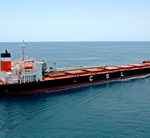Parker support helps boost productivity of bulk carrier fleet

Parker Hannifin has worked together with EMS-Tech, a major designer and supplier of bulk material handling and storage systems, to help them quickly and cost effectively develop an integrated unloading system for a fleet of new forebody vessels. 25 ton Parker hydraulic rotary actuators, among the largest the company has ever built, enable the discharge boom on board the ships to be positioned accurately and held in place, allowing cargo to be deposited on shore quickly and safely.
Conveyor and boom systems offer an efficient method of unloading materials from a bulk carrier, minimising turnaround times and saving port, crane, and labour costs. Typically, a conveyor system carries dry bulk cargo from the ship’s hold and elevates it onto a deck-mounted boom conveyor. The end of the boom is then manoeuvred to deposit the cargo into a receiving hopper or onto a stockpile located on shore. Equipped with a self-unloading system, a vessel can discharge its cargo almost anywhere: into an adjacent vessel, on-shore hopper, stockpile, or even onto another conveyor.
Prior to the introduction of the hydraulic slew actuator, wire rope winches were used to position the boom; however, these systems were limited in terms of the levels of positional accuracy and load carrying capacity that they were capable of. To provide a more accurate, reliable and efficient method of control, the latest generation of self-unloaders luff and slew the boom using hydraulic actuators.
When looking for a hydraulic rotary actuator large and powerful enough to position the loaded discharge boom on board a fleet of bulk carriers, EMS-Tech approached Parker. John Elder, Vice President - Marine Systems at EMS-Tech, explained, “Our client, CSL International, was looking to complete a huge fleet renewal programme of its self unloaders. As well as requiring a more efficient and reliable unloading system that would enable them to optimise productivity levels, CSL needed to carry out the project in the shortest time and at the minimum cost. To do this, it was decided that the aft end of existing single skin tankers would be combined with new forebodies comprising fully integrated self-unloading systems.”
He continued, “When it came to the design and supply of the boom slew system, we turned to Parker, having had a successful relationship with them for 30 years. Parker were the only company we could think of with the technology to meet the demands of the application and the ability to meet our deadlines.”
When designing the actuator for this challenging application, Parker had to consider a wide range of system parameters, including the operating environment, slewing speed, and duty cycle, in addition to factors such as the ship list angle and wind load on the boom, which could greatly influence the torque needed to position the boom effectively. In addition to providing the torque required to slew the discharge boom, the actuator serves to support this very large boom structure and all imposed loads, which can be well in excess of 500 tons; all of this needs to be carried out in tough environmental conditions.
Following extensive co-ordination between Parker’s hydraulics specialists and EMS-Tech engineers, a design was developed that could meet these demanding requirements. The Parker solution took the form of a 25 ton rack-and-pinion hydraulic rotary actuator, coated with a rubberised epoxy paint at 175 micron dry film thickness to protect the system from corrosion in the hostile working environment. The purpose-built system is able to control the boom accurately and reliably, providing 4.3 million Nm of holding torque and 3.5 million Nm of slewing torque at 275 bar. The finished system is capable of discharging a variety of materials, including coal, stone, grain, ore, alumina, and limestone rocks at a rate of 5000 tons per hour.
The unique actuator features a pinion gear bore that fits over a king pin tied into the structure of the ship. The gear is fixed so that the housing rotates as pressure is applied to the cylinders, causing the actuator to turn at 12º per minute. To give an idea of the scale of the cylinders, approximately 450 litres of oil are displaced for every 190º of rotation.
The boom is attached to the actuator by two trunnion pins that project from the sides of the actuator housing. These trunnion pins carry the weight of the boom, in addition to transferring the torque from the actuator into the boom to rotate it off the centreline of the ship and into the required position. The actuator is then able to hold the boom steadily against the torque generated by the list of the ship, as well as the wind loads trying to rotate the boom further.
A separate luffing cylinder and a rigid luffing linkage assembly are used to control the boom vertically. This arrangement allows the boom to be positioned along the centreline of the vessel in a storage saddle when it is not in use, and, likewise, to be lifted out of the storage position when it is required.
With the bespoke rotary actuator assembled and connected to a purpose built hydraulic power unit, complete with directional valves, holding valves, and filtration equipment, Parker was able to help EMS-Tech meet its client’s requirements simply, quickly and cost effectively. John Elder commented, “Parker’s support was integral to the success of the renewal programme. The quality and efficiency of the finished solution makes us confident that we made the right decision to work with Parker on the project.”
Similar articles
More from Parker Hannifin
- Flange system gains new certification for marine applications 4th June 2021
- New generation of oil condition monitoring technology 2nd June 2021
- Parker introduces new low GWP refrigeration dryer series 24th November 2020
- Steering into the future for mobile machinery 17th November 2020












Write a comment
No comments